Turkish and Other Delights columnist Elizabeth Wolfson is filling in for regular Inside the Artist’s Studio writer Georgia Kotretsos this month and next. — Ed.
Ben Durham lives and works in Midway, Kentucky, just outside of his hometown of Lexington. He received a B.F.A from Washington University in St. Louis in 2004. His work has since been included in exhibitions at Country Club, Cincinnati, OH and the 21C Museum in Louisville, KY and is held in several private and public collections including that of the Whitney Museum of American Art. He has been an artist-in-residence at Cité Internationale des Arts in Paris (2010) and the Columbia College Center for Book and Paper Arts in Chicago (2009). Currently, Durham is the subject of two solo exhibitions that opened simultaneously this month at the Nicole Klagsbrun Gallery in New York City and Marc Selwyn Fine Art in Los Angeles.
Durham’s practice functions as a highly personalized exploration of the nature of memory, a close analysis of the twin processes of remembering and forgetting. The subjects of Durham’s portraits are friends, classmates and acquaintances from his childhood in Lexington. In a ritualistic daily process, Durham combs the Lexington police reports for familiar names and faces, collecting their mug shots and arrest records. Through a variety of techniques, he merges disparate bodies of knowledge—the account created by the Lexington police department, his own memories of these individuals, maps of neighborhoods related to their lives—to create new portraits and new maps that provide a more complete and complex history.

Ben Durham, "Robert," graphite text on handmade paper, 2010. Courtesy the artist and Nicole Klagsbrun Gallery, New York.
In his Text Portraits, Durham creates a written account of excavated memories of the subject, using it to create an eerily accurate portrait of the individual composed entirely of text. Often densely layered, the text wears away the paper’s surface to depict shadows, hair and eyes, while light cheeks and shoulders remain legible. In his series of Map Diptychs, lines representing the streets where the subject has lived repeat over each segment, acting as a kind of topographic skeleton underlying the subject’s silhouette on one side of the diptych, and on the other as an abstract diagram. In a third series, the Map Composites, dyed paper is sliced along the street grids of specific neighborhoods relating to each subject. These pieces are reconfigured and arranged to form a silhouette of the subject’s mug shot, creating “new combined streets and territories… a personal topography built of many maps.” Due to his thoughtful creative process and rigorous studio practice, Durham makes an ideal subject for Inside the Artist’s Studio.
Elizabeth Wolfson: Can you describe the evolution of the process utilized in the Text Portraits? How did you develop this process? What was the initial inspiration?
Ben Durham: Learning to make paper as a student at Washington University in St. Louis was the catalyst for the creation of the first Text Portrait. I viewed the papermaking process as a sort of meditative performance and, in the end, it changed the way I thought about artmaking. Quite simply, I was faced with the first blank sheet and realized no way I had worked in the past would serve the nuances and conceptual potential of the handmade paper. Before any drawing was begun, before I even knew what I wanted to draw, the paper appeared as a monumental headstone, an Anselmo stonework, a skin surface marked by a history of scars and wrinkles, an unmarked map without orientation. Honestly, before I even knew what to draw, I was perfectly aware that the sheet of paper was already the most interesting thing I had ever made.
Quite intimidated, I set about to reinvent my way of drawing so that it would parallel the process of papermaking. I slowed down my process as much as possible, building imagery at first with tiny tick-marks, as repetitive and ritualistic as the laying out of wet pulp. To mark the sheet in such a way required little concentration and I was able to approach it as a kind of meditation, a time of forced meditation upon the memories of half-forgotten friends and classmates whom I had recently rediscovered via their mug shots and arrest records on an online database. Halfway through the first portrait composed of tick-marks, I came to the realization that I could externalize the inner monologue of memories and create the portrait not with tick-marks, but with handwritten words. From then on, I have developed a method of drawing that is done entirely with hand-written text. The text represents a graphic, unedited recounting of everything I know, can remember, and have been told about the subject. To build the tonal features of the face, I repetitively layer that text. Working in such a way, the creation of the drawing destroys the narrative content. The soft texture of the paper begins to tear under the force of the pencil, the words get lost among the palimpsest of information. In areas of highlight in the portrait, some text remains legible, but I’ve become much more interested in the text that is rendered illegible.
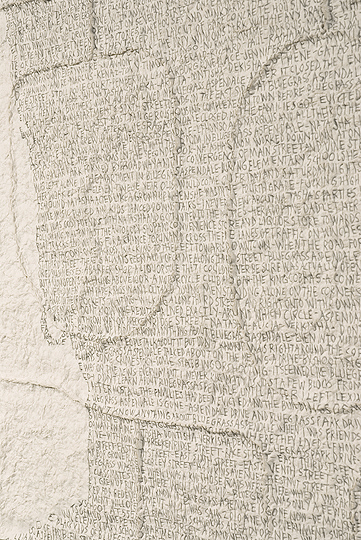
Ben Durham, "Jennifer (Race St/3rd St)" (detail), graphite text on handmade paper, 2009. Courtesy the artist and Nicole Klagsbrun Gallery, New York.
These pieces do not begin with the first graphite mark; they begin with the first handful of wet pulp laid out into the frame that forms the large-scale sheets of paper. Most of the sheets are 44″ x 58” and ¾ ” thick. It’s a sort of sculpting. Long before I begin to draw, I must consider the dimensionality of the paper and the creation of a unique and highly textured topography on which the drawing will be forced (not the other way around).
EW: How do you produce the text? Do you view the process of creating the textual reflection on the subject differently from the creation of the portrait?
BD: The text is composed when I sit down in front of the sheet. That time is still dedicated to meditating on the subject, struggling to remember, fighting against the fact that I have forgotten so much. There is a distinct shift when I switch from actively reflecting and writing to layering and rendering the actual portrait—you might call it the distinction between creating and destroying. At first, I sincerely strive to create as accurate a narrative as possible. I strive to find some way to tell the subject’s story and yet I know I will fail to do so. That failure is inherent in the text, just as, in my mind, it is inherent in the retelling of any story or history. That failure is made visual in the creation of these portraits. As I’m fond of saying, it is a history deconstructed. Perhaps if I want to be more honest, I should say it is a failed history deconstructed.
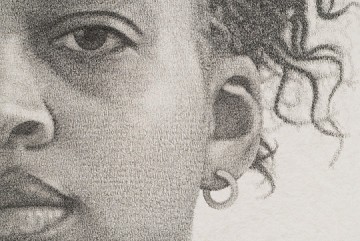
Ben Durham, "Jennifer" (detail), graphite text on handmade paper, 2010. Courtesy the artist and Nicole Klagsbrun Gallery, New York.
EW: Are your subjects aware of their role in your artwork? Have you received any reactions to their representation from any of your subjects or anyone that knows them? Do you have any desire to see these people again or find out what happened in their lives between the last time you interacted with them and your discovery of their mug shot?
BD: I have had no real contact with any of the subjects since I was in grade school. Most I have not even seen in well over a decade. As far as I know, none are aware of my work. The work, I think, reflects the awkward tension created by this. It also certainly addresses a simultaneous dread and romanticization of the past. The work is not a process of getting closer or removing the boundaries, but a claim of the territory somewhere in between.
I dedicate a large part of my life to the memories and stories of these people yet make no attempt to contact them. I constantly wonder whether I would say hello if I saw them on the street. The truth is, I still spend a great deal of time in the same community as them, walking and driving along the same streets and yet we remain entirely separate. While we live our lives in close geographic proximity, the cultural and social distance is profound and much more powerful. I’ve shown in the past in Lexington, and though the subjects have probably walked past the gallery space, there is a distance, though not a physical one, that seems to dictate that our paths do not intersect again. Without this odd distance, this tension, the work would lose much of its power. My work demonstrates my long-held belief that art is a mirror of social relationships, mimicking how we see and interact with the world.
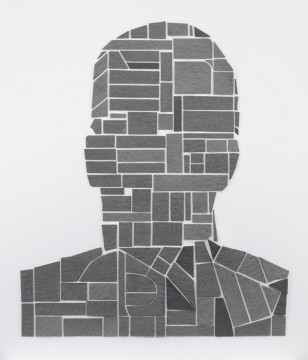
Ben Durham, "Robert (4 Maps)," cut handmade dyed paper, 2010. Courtesy the artist and Nicole Klagsbrun Gallery, New York.
EW: You’ve described the process of creating your Map Diptychs as “pinching” the drawing into the paper. Can you explain exactly how this works?
BD: The series of Map Diptychs began in 2009 while at a residency at Columbia College in Chicago. For years I had been manipulating the surface of the paper to create the unique topography of each sheet, but I always wanted to further emphasize the importance of that manipulation. I wanted to use the process of papermaking to create the imagery of the work. I wanted to imprint the imagery into the paper’s surface. The paper I’ve made has always contained a history that, in some way, marks whatever is drawn onto it, but I wanted to take that even further. Emphasizing the skin-like qualities of the paper, I developed two methods of imprinting the imagery of city street maps into the paper while still wet and malleable. The first is done using a pulp-painting technique. Unlike most paint, which sits on the surface, pulp-painting inserts the pigment, in the form of dyed pulp, into the paper, like a tattoo or a vein under the skin. The pinching you mention refers to the second method which, quite simply, involves manipulating the surface of the paper while it is still wet, pinching the surface into raised ridges which follow the linear diagram of the map. These bas-relief ridges reference scarification, a history of experience and, in the case of these map-based works, a history of places marked on the skin.
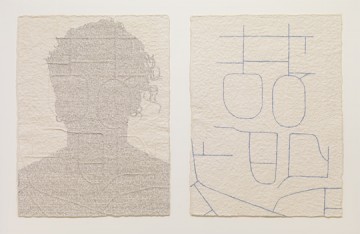
Ben Durham, "Jennifer (Race St/3rd St)," graphite text on handmade paper, 2009. Courtesy the artist and Nicole Klagsbrun Gallery, New York.
EW: It seems that your practice (and potentially your lifestyle generally) is fairly isolated–you live in a very small town in Kentucky, you and your wife live in a house alone, you have few visitors to your studio. Have you consciously sought out this isolation for reasons connected to your artwork? How has your work or practice been different when you’ve lived in less isolated circumstances?
BD: I feel that most of the work is inherently slow, reliant on a certain pace, a certain mental and physical space to meditate. I like having a mental and physical space of my own where I can create a world populated by these subjects, these representations of old friends for whom I feel both warmth and a certain repulsion, if not outright fear. When I’m in the studio, which can be a sort of hiding place or vacuum, I’m free to explore. In a removed location like Kentucky, I’m free to determine how and when I interact with the art world, and how I live a life among people who don’t particularly care what I’m doing, where I’m showing, and all the rest.
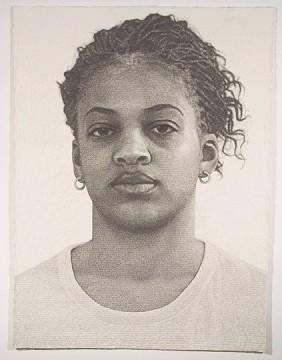
Ben Durham, "Jennifer," graphite text on handmade paper, 2010. Courtesy the artist and Nicole Klagsbrun Gallery, New York.
EW: I know you’re very focused on producing work for your upcoming solo shows opening simultaneously next month in New York and Los Angeles. Is it possible for you to look beyond these shows and talk about your creative and professional plans, goals, and aspirations for 2011?
BD: I’ll be working temporarily from Manhattan while the two solo shows are open at Nicole Klagsbrun Gallery and Marc Selwyn Fine Art. I’ll be developing new series that push the physicality and dimensionality of the work. Right now, I’m most excited about some new stained glass work I’m developing with a great stained glass artist, Frank Close. It’s been extremely productive and great fun to invoke the beauty and tradition of that form while doing my best to subvert it. Saying that, I don’t think it’s quite true; instead I see myself trying to link that beauty and tradition with these people and stories that are marked by a mixture of the violent, the pitiful, and, maybe most disturbing of all, the ordinary.

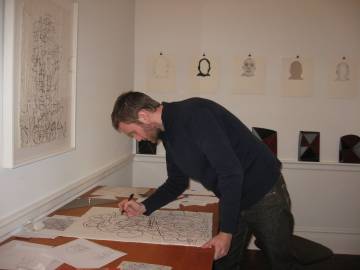



Pingback: CHARCOAL INSPIRATION: Ben Durham - Nitram Charcoal / Nitram Charcoal
Pingback: 10 Painstakingly Crafted Data Portraits That Reveal Strange Details of People’s Lives | ARTnews
Pingback: 10 Painstakingly Crafted Data Portraits That Reveal Strange Details of People’s Lives - MancArt Blog